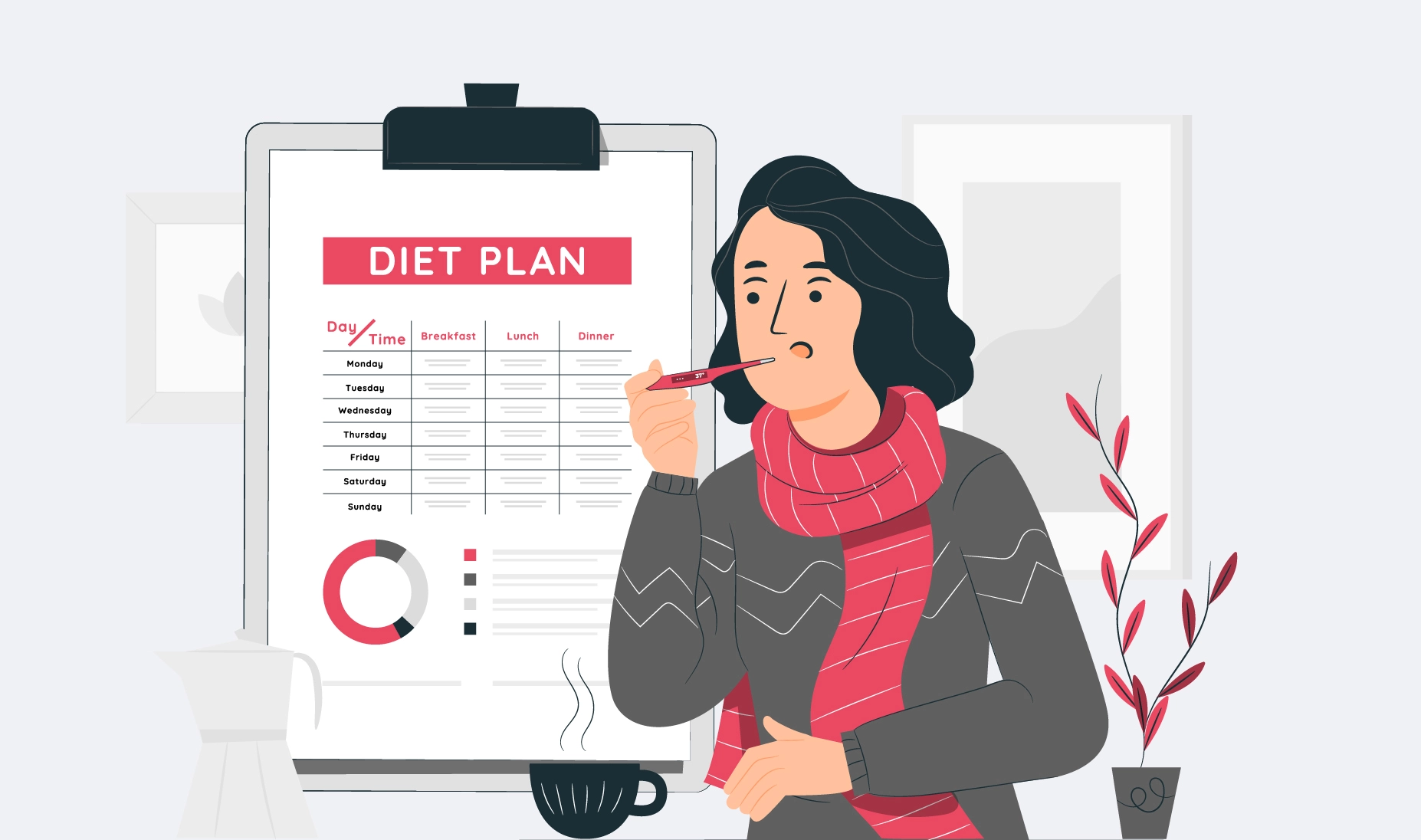Jaundice Diet Chart- Best Diet Plan and Food for Jaundice Patient

Jaundice is a condition which is caused due to high bilirubin levels. This condition is characterized by the yellowing of the skin and eyes of the patient. For jaundice patients, the best diet is the one that focuses on avoiding fatty food and staying hydrated to enhance liver function and recovery. Jaundice is very common among newborn babies and children. Even grown-ups can suffer from jaundice and may need a proper diet plan to recover completely.

Do you know the first disease that a child suffers from within a couple of days after birth is most likely to be jaundice? It is a disease most commonly found in children, but even adults can suffer from it at any age. This disease is caused because of high bilirubin levels due to improper functioning of the liver. The most common jaundice symptom is that a person’s skin and eyes turn yellowish. Apart from the medicines, a Jaundice diet plan can help get over the symptoms of this ailment.
This article aims to guide you with the most suitable jaundice diet chart. Read the complete article to also know about foods to avoid during jaundice.
Role of Food for Jaundice
The liver plays a vital role in our body to remove toxins and damaged blood cells. In Jaundice, this very part of our body gets affected and slows down. The combination of the right food items can help improve liver health and relieve jaundice symptoms for a patient.
To recover fast from this disease, patients are thus suggested with certain food items to heal the liver. Therefore, a balanced food diet plays a crucial role in recovering from jaundice.
10 Best Food for Jaundice Patients
You just learned how food plays a major role in curing “Peeliya”, also known as Jaundice. So, let’s discuss what to eat in Jaundice.
- Water: The key to recovering from jaundice is drinking a lot of water. It will help the liver to function properly. However, ensure drinking boiled or purified water to minimize the chances of contracting any further infection.
- Tea or Coffee: A jaundice patient must also take high doses of antioxidants that are easily found in herbal teas and coffees. But ensure taking these liquids in moderate amounts to avoid further damage to your liver.
- Fresh Fruits: When it comes to recovering from any disease, fresh fruits play an important role. Include citrus fruits like lemons and oranges; berries like blueberries and cranberries; and other fruits like papaya, watermelon, and chiku.
- Fresh Vegetables: Apart from fresh fruits, include fresh vegetables in your list of jaundice food to eat. Add vegetables like carrot, pumpkin, ginger, garlic, tomato, spinach, broccoli, and cauliflower.
- High-Fiber Food: Reserve one portion of your jaundice diet for high-fiber food, which will help to improve digestion and liver function. Some great options that are rich in fiber for a jaundice patient are broccoli, berries, chickpeas, oatmeal, and almonds.
- Lean Proteins: Do include lean protein food items such as tofu, fish, and fish in your jaundice diet. These are rich in zinc and Omega-3, which will help heal your stressed-out liver.
- Milk Thistle: Rich in antioxidants, milk thistle has one important compound called Silymarin, which helps to heal damaged liver cells. So, add milk thistle to your salad, snacks, and teas to recover fast.
- Nuts: Also, add nuts to your Jaundice diet. These are rich in Vitamin E, antioxidants, and Omega-3. Some healthy nut options for a jaundice patient are almonds, raisins, and walnuts. Try having them in soaked form for better digestion.
- Legumes: Just like nuts, do add legumes to your jaundice diet plan. These are good sources of healthy fats, proteins, phenolic acid, and fiber. Eating at least one cup of legumes per day will help to strengthen your liver.
- Whole Grains: Whole grains are a storehouse of liver-friendly nutrients, so do include these in a Jaundice diet for relief. These grains are also a rich source of fiber, minerals, and healthy fats.
Foods that a jaundiced patient can easily consume
The table below mentions the food items that can be consumed by a jaundice patient
| Cereals such as porridge can be eaten | Low-fat milk as well as products made from milk such as low-fat curd can be consumed |
| A jaundice patient can eat all kinds of vegetables, especially gourds like snake gourd, bitter gourd, bottle gourd, ridge gourd, and ivy gourd. They can also consume vegetables like ladies’ fingers, potatoes, carrots, beetroots, and all the green leafy vegetables. |
Among fruits that can be consumed include banana, citrus fruits like grapefruit, orange, and sweet lime, and berries like strawberry, blackberry, and blueberry. Also, they can consume other fruits like pears, watermelon, and grapes |
| Vegetables should be properly cooked while preparing for a jaundice patient | Other beverages like buttermilk and fresh fruit juice prepared at home can be consumed |
| Meat and Fish should be avoided during the initial days when the patient is recovering. | Pulses should also be avoided during the first few days of recovery |
Diet Chart for Jaundice Patient
A patient can recover fast with the best jaundice diet plan shared below:
| Breakfast | Brunch | Lunch | Evening Snack | Dinner |
|---|---|---|---|---|
| A bowl of vegetable soup like beetroot soup, tomato soup, and carrot soup | A glass of tender coconut water | ½ cup of khichdi | 1 cup of black tea/herbal tea/ buttermilk | ½ cup of boiled rice/ khichdi |
| A bowl of poha/ vermicelli | A bowl of fresh fruits like papaya, oranges, guava, apples, or grapes | 2 Rotis with fish curry/ ½ cup of boiled rice/ plain dosa with sambar | A bowl of roasted rice flakes/boiled black grams | A bowl of bottle gourd curry/ dal |
10 Foods to Avoid in Jaundice
After learning about jaundice treatment food, it is time you also learn about what not to eat in jaundice, so have a look:
- Alcohol
- Sugar
- Dairy Products and Eggs
- Fried Food
- Spicy Food
- Refined Carbs
- Packaged/ Canned Food
- Meat and Uncooked Fish
- Pulses
- Butter and Oils
Do’s And Don’ts During Jaundice
The table below is a guide for your dos and don’ts when it comes to caring for a jaundice patient:
| Do’s | Don’ts |
|---|---|
| Eat a lot of cooked vegetables made with little or no oil such as carrots, potatoes, and cauliflower. These vegetables will fulfill the requirement for vitamins B and C for better recovery | Do not consume foods high in fats. Avoid fried and oily food as well as red meats. Your liver may not be strong enough to bear the strain caused by these food items. Also, avoid sugar-rich foods or food with artificial sweeteners |
| Drink plenty of vegetable soups (thinned) along with other liquid beverages like buttermilk, cold milkshakes, and custards in between your meals | Avoid outside food, even the juices prepared outside at eateries or packed juices |
| Consume carbohydrate-rich food such as cereals, rice, roti, and porridge to ensure an adequate supply of calories and to avoid the breakdown of protein | Don’t eat large meals rather go for small meals frequently |
FAQs: Best Diet Plan & Food for Jaundice Patient
Yes, you can eat potatoes in jaundice but in a baked or roasted form. Avoid eating potatoes cooked in oil.
Jaundice patients can experience a lot of relief by adding soups, fresh fruit juices, and broth to their diet. However, these should be added in moderate amounts.
One can get relief from jaundice symptoms by:
Getting ample sunlight
Eating fruits like papaya, oranges
Taking ample rest
Avoiding outside cooked food
Staying hydrated
No, a jaundice patient must not include milk or any other dairy product in the diet plan. These will be hard to digest by the liver and might worsen the symptoms.
The three types of Jaundice are:
Pre-Hepatic Jaundice
Hepatocellular Jaundice
Post-Hepatic Jaundice
Jaundice is mainly a liver problem. It is caused due to a build-up of bilirubin in the body due to excessive red blood cells drying and accumulating in the liver.
If a policyholder needs hospitalization due to jaundice, then the cost of hospitalization and other similar expenses will be covered under a health insurance plan. But we suggest you check for the same from your insurer before claiming.

Author Bio
Paybima Team
Paybima is an Indian insurance aggregator on a mission to make insurance simple for people. Paybima is the Digital arm of the already established and trusted Mahindra Insurance Brokers Ltd., a reputed name in the insurance broking industry with 17 years of experience. Paybima promises you the easy-to-access online platform to buy insurance policies, and also extend their unrelented assistance with all your policy related queries and services.
Other Health Insurance Products
Latest Post
In a country where medical inflation is rising rapidly, securing a comprehensive health coverage plan for the entire family is no longer optional, it is essential. Selecting the right health insurance requires careful evaluation of multiple factors, not just premium costs. A well-chosen plan ensures financial security, access to quality healthcare, and peace of mind during medical emergencies.


Term insurance is an important investment. However, with the availability of so many insurers offering term plans, it becomes difficult to select the best term plan to suit your needs. Buying a term plan needs some consideration and research on the part of the policyholder. In this post, let us discuss the best term insurance providers in India.


Have you ever caught yourself lost in illusions about your daughter's future events, such as her university convocation and first day at work? Her university convocation. When she embarks upon her initial job after graduation will be the day.

.png)
When you sign up for a life insurance policy - whether it’s a traditional term insurance policy or a ULIP – you are not just buying peace of mind. You are also trusting the insurer with your money. So naturally, you would want to know: How is that money being managed? And more importantly, how is it being protected from risky decisions?

.png)
Globally, 20th October marks the day to observe World Osteoporosis Day. Do you know the significance of observing Osteoporosis on a global platform? Do you know how this condition affects people and their lives? Let us find out in this post!




